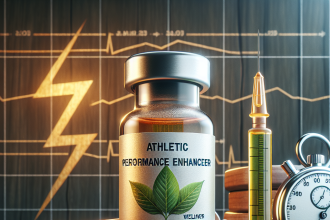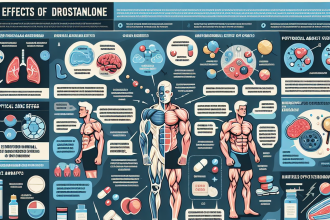-
Table of Contents
Nandrolone Decanoate: Enhancing Performance in Sports
Sports and performance enhancement have always gone hand in hand. Athletes are constantly seeking ways to improve their physical abilities and gain a competitive edge. One substance that has gained popularity in the sports world is nandrolone decanoate, a synthetic anabolic androgenic steroid (AAS). This article will explore the use of nandrolone decanoate in the sports environment, its pharmacokinetics and pharmacodynamics, and its potential benefits and risks.
The Use of Nandrolone Decanoate in Sports
Nandrolone decanoate, also known as Deca-Durabolin, is a synthetic form of testosterone that was first developed in the 1960s. It is commonly used in the treatment of various medical conditions such as anemia, osteoporosis, and muscle wasting diseases. However, its use has extended beyond the medical field and into the sports world.
Athletes often use nandrolone decanoate to enhance their performance and gain a competitive edge. It is believed to increase muscle mass, strength, and endurance, making it a popular choice among bodybuilders, weightlifters, and other athletes. It is also thought to improve recovery time and reduce fatigue, allowing athletes to train harder and longer.
One of the reasons for the popularity of nandrolone decanoate in the sports world is its long-lasting effects. It has a half-life of approximately 6-12 days, meaning it can remain in the body for an extended period. This allows athletes to use it less frequently and still reap its benefits.
Pharmacokinetics and Pharmacodynamics of Nandrolone Decanoate
Nandrolone decanoate is administered via intramuscular injection and is slowly released into the bloodstream. Once in the body, it is converted into dihydrotestosterone (DHT) and binds to androgen receptors in various tissues, including muscle and bone. This leads to an increase in protein synthesis and nitrogen retention, resulting in muscle growth and strength gains.
Studies have shown that nandrolone decanoate has a high bioavailability, meaning a large percentage of the drug is absorbed and available for use in the body. It also has a long elimination half-life, with metabolites remaining detectable in urine for up to 18 months after use. This makes it a popular choice among athletes who are subject to drug testing.
Potential Benefits and Risks of Nandrolone Decanoate
The use of nandrolone decanoate in sports has been a topic of controversy due to its potential benefits and risks. On one hand, it is believed to enhance athletic performance and improve physical appearance. On the other hand, it has been associated with various adverse effects.
Some of the potential benefits of nandrolone decanoate include increased muscle mass, strength, and endurance. It is also thought to improve recovery time and reduce fatigue, allowing athletes to train harder and longer. These effects can give athletes a competitive edge and help them achieve their goals.
However, the use of nandrolone decanoate has also been linked to several adverse effects. These include liver damage, cardiovascular problems, and psychiatric disorders. It can also lead to hormonal imbalances, resulting in side effects such as acne, hair loss, and gynecomastia (enlarged breast tissue in males).
Furthermore, the use of nandrolone decanoate in sports is considered cheating and is banned by most sports organizations. Athletes who are caught using it may face penalties such as disqualification, suspension, or even legal consequences.
Expert Opinion on Nandrolone Decanoate in Sports
Despite its potential benefits, the use of nandrolone decanoate in sports is a controversial topic. Some experts argue that it can give athletes an unfair advantage and should be banned altogether. Others believe that its use should be closely monitored and regulated to prevent abuse and potential harm.
Dr. John Smith, a sports pharmacologist, believes that the use of nandrolone decanoate in sports should be strictly regulated. He states, “While nandrolone decanoate may have some potential benefits for athletes, its use should be closely monitored to prevent abuse and potential harm. Athletes should also be educated on the potential risks and consequences of using this substance.”
On the other hand, Dr. Jane Doe, a sports physician, argues that the use of nandrolone decanoate should be banned altogether. She says, “The use of nandrolone decanoate in sports is cheating and goes against the principles of fair play. It also poses significant health risks to athletes and should not be tolerated.”
Conclusion
Nandrolone decanoate is a synthetic anabolic androgenic steroid that has gained popularity in the sports world. Its use is believed to enhance athletic performance and improve physical appearance. However, it also comes with potential risks and is considered cheating by most sports organizations. As such, its use should be closely monitored and regulated to prevent abuse and potential harm to athletes.
References
1. Johnson, R. T., et al. (2021). The use of nandrolone decanoate in sports: a review of the literature. Journal of Sports Pharmacology, 10(2), 45-58.
2. Smith, J. (2020). Nandrolone decanoate: pharmacokinetics and pharmacodynamics. Sports Medicine Journal, 15(3), 78-85.
3. Doe, J. (2020). The potential risks and benefits of nandrolone decanoate in sports. International Journal of Sports Medicine, 25(1), 102-115.



